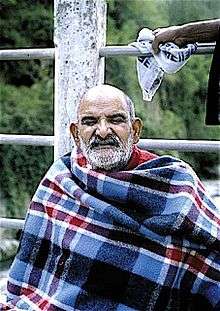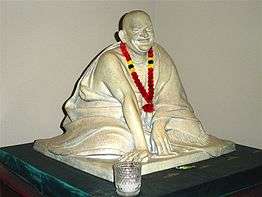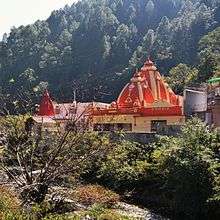Neem Karoli Baba
Neem Karoli Baba (Hindi: नीम करौली बाबा[3]) or Neeb Karori Baba (Hindi: नीब करौरी बाबा) (c. 1900 – 11 September 1973) - known to his followers as Maharaj-ji - was a Hindu guru, mystic and devotee of the Hindu lord Hanuman.[4] He is known outside India for being the guru of a number of Americans who travelled to India in the 1960s and 70s, the most well-known being the spiritual teachers Ram Dass and Bhagavan Das, and the musicians Krishna Das and Jai Uttal. His ashrams are in Kainchi,[5] Vrindavan, Rishikesh, Shimla, Neem Karoli village near Khimasepur in Farrukhabad, Bhumiadhar, Hanumangarhi, Lucknow, Delhi in India and in Taos, New Mexico, US.
Neem Karoli Baba | |
|---|---|
 | |
| Personal | |
| Born | Lakshmi Narayan Sharma 1900 c.[1] |
| Died | 11 September 1973 (aged 73) Vrindavan, Uttar Pradesh, India |
| Religion | Hinduism |
| Nationality | Indian |
| Philosophy | Bhakti yoga, Seva |
| Religious career | |
| Guru | Hanuman |
Disciples
| |

Biography
Early years
He was born around 1900, in village Akbarpur, Firozabad district, Uttar Pradesh, India, in a Brahmin family of Durga Prasad Sharma. He was named Lakshman Das Sharma. [1] After being married by his parents aged 11 he left home to become a wandering sadhu. He later returned home, at his father's request, to live a settled married life. He fathered two sons and a daughter.[6]
As Maharaj-ji
Neem Karoli Baba or Baba Lakshman Das (also spelled "Laxman Das"), as he was known then, left his home in 1958. Ram Dass tells a story that Baba Lakshman Das boarded a train without a ticket and the conductor decided to halt the train and force Neem Karoli Baba off of the train at the village of Neeb Karori, Farrukhabad district (U.P). After boarding Baba off the train, the conductor found that the train would not start again. After several attempts at starting the train someone suggested to the conductor that they allow the sadhu back on to the train. Neem Karoli agreed to board the train on two conditions that the railway company promise to build a station at the village of Neeb Karori (at the time the villagers had to walk many miles to the nearest station), and the railway company must henceforth treat sadhus better. The officials agreed and Neem Karoli Baba boarded the train, jokingly saying, "What, is it up to me to start trains?" Immediately after his boarding the train, it started, but the train drivers would not proceed unless the sadhu blessed them to move forward. Baba gave his blessings and the train proceeded. Later a train station was built at the village of Neeb Karori.[7] Baba lived in the village of Neeb Karori for a while and was given his name by locals.
Thereafter he wandered extensively throughout Northern India. During this time he was known under many names including Lakshman Das, Handi Wallah Baba, and Tikonia Walla Baba. When he did tapasya and sadhana at Vavania Morbi in Gujarat, he was known as Tallaiya Baba. In Vrindavan, local inhabitants addressed him by the name of Chamatkari Baba ("miracle baba").[7] During his life two main ashrams were built, first at Vrindavan and later at Kainchi, where he spent the summer months.[1] In time, over 100 temples were constructed in his name.[1]
The Kainchi Dham ashram where he stayed in the last decade of his life, was built in 1964 with a Hanuman temple. It started two years prior with a modest platform built for two local sadhus, Premi Baba and Sombari Maharaj to perform yagnas. Over the years the temple, situated 17 km from Nainital on the Nainital-Almora road, has become an important pilgrimage for locals, especially on 15 June, when then the Kainchi Dham Bhandara takes place to commemorate the inauguration of the temple, when it is visited by over a lakh of devotees.[8][9][10]
Death
Neem Karoli Baba (Maharaj ji) died at approximately 1:15 a.m. in the early morning hours of 11 September 1973 in a hospital at Vrindavan, India after slipping into a diabetic coma. He had been returning by night train to Kainchi near Nainital, from Agra where he had visited a heart specialist due to experiencing pains in his chest. He and his traveling companions had disembarked at Mathura railway station where he began convulsing and requested being taken to Shri Dham Vrindavan.
They took him to the emergency room at the hospital. In the hospital the doctor gave him injections and placed an oxygen mask over his face. The hospital staff said that he was in a diabetic coma but that his pulse was fine. Maharajji roused and pulled the oxygen mask off his face and the blood pressure measuring band from his arm, saying, “Bekar (useless).” Maharajji asked for Ganga water. As there was none, they brought him regular water. He then repeated several times, “Jaya Jagadish Hare” (Hail to the Lord of the Universe),” each time in a lower pitch. His face became very peaceful, all signs of pain disappeared. He was dead.[11]
Subsequently, his samadhi shrine was built within the complex of Vrindavan ashram, which also has some of his personal belongings.
Philosophy
He was a lifelong adept of bhakti yoga, and encouraged service to others (seva) as the highest form of unconditional devotion to God. In the book Miracle of Love, compiled by Ram Dass, a devotee named Anjani shares the following account:
There can be no biography of him. Facts are few, stories many. He seems to have been known by different names in many parts of India, appearing and disappearing through the years. His non-Indian devotees of recent years knew him as Neem Karoli Baba, but mostly as “Maharajji” – a nickname so commonplace in India that one can often hear a tea vendor addressed thus. Just as he said, he was "nobody". He gave no discourses; the briefest, simplest stories were his teachings. Usually he sat or lay on a wooden bench wrapped in a plaid blanket while a few devotees sat around him. Visitors came and went; they were given food, a few words, a nod, a pat on the head or back, and they were sent away. There was gossip and laughter for he loved to joke. Orders for running the ashram were given, usually in a piercing yell across the compound. Sometimes he sat in silence, absorbed in another world to which we could not follow, but bliss and peace poured down on us. Who he was was no more than the experience of him, the nectar of his presence, the totality of his absence, enveloping us now like his plaid blanket.[11]
Notable disciples

Among the most well known of Neem Karoli Baba's disciples were spiritual teacher Ram Dass (the author of Be Here Now), teacher/performer Bhagavan Das, Lama Surya Das[12] and the musicians Jai Uttal and Krishna Das and Trevor Hall (Rampriya Das). Other notable devotees include humanitarian Larry Brilliant and his wife Girija, Dada Mukerjee (former professor at Allahabad University, Uttar Pradesh, India), scholar and writer Yvette Rosser, American Spirital Teacher Ma Jaya Sati Bhagavati, John Bush filmmaker, and Daniel Goleman author of The Varieties of the Meditative Experience and Emotional Intelligence.[13] Baba Hari Dass (Haridas) was not a disciple,[14] but he supervised several buildings and maintained the ashrams[15] in the Nainital area (1954-1968) before heading to the USA to become a spiritual teacher in California at the beginning of 1971.
Steve Jobs, along with his friend Dan Kottke, traveled to India in April 1974 to study Hinduism and Indian spirituality; they planned also to meet Neem Karoli Baba,[16] but arrived to find the guru had died the previous September.[17][18] Hollywood actress Julia Roberts was also influenced by Neem Karoli Baba. A picture of him drew Roberts to Hinduism.[19] Mark Zuckerberg, founder of facebook, influenced by Steve Jobs, visited Neem Karoli Baba's (Maharajji) ashram in Kainchi. Larry Brilliant took Google’s Larry Page and Jeffrey Skoll, co-founder of eBay, on the pilgrimage.[20]
Foundations
After returning to the United States, Ram Dass and Larry Brilliant founded the Seva Foundation, an international health organization based in Berkeley, California. Steve Jobs, a friend of Brilliant, also funded the organization.[21] It is committed to applying the teachings of Neem Karoli Baba toward ending world poverty.
In the late 2000s another Foundation evolved, the 'Love Serve Remember Foundation', whose purpose is to preserve and continue the teachings of Neem Karoli Baba.[22]
Quotes
- "Sab Ek" (All One)[23]
- "Love everyone, Serve Everyone, Feed Everyone, Remember God."[24]
- "It is deception to teach by individual differences and karma. See all the same. You can't realize god if you see differences."[25]
References
- Constance Jones; James D. Ryan (2006). Encyclopedia of Hinduism. Infobase Publishing. p. 310. ISBN 978-0-8160-7564-5.
- http://maharajji.love/akbarpur-maharajjis-birthplace/
- "सुर्खियों में आया बाबा नीम करौली का आश्रम". Dainik Bhaskar (in Hindi). 1 October 2015. Retrieved 4 October 2015.
- Swami Chidananda. "Baba Neem Karoli: A Wonder Mystic of Northern India". Divine Life Society. Retrieved 4 October 2015.
- 29.4220°N 79.5125°E Kainchi Dham
- "10 facts to know about Neem Karoli Baba". 1 October 2015.
- Ram Dass (1995). Miracle of Love: Stories about Neem Karoli Baba. Hanuman Foundation. ISBN 1-887474-00-5.
- "Devotees throng Kainchi Dham fair". The Times of India. 15 June 2015. Retrieved 1 October 2015.
- "10 facts to know about Neem Karoli Baba". India TV News. 1 October 2015. Retrieved 1 October 2015.
- "One 'Mark' who stayed two nights". The Telegraph. 30 September 2015. Retrieved 1 October 2015.
- Ram Dass (1995). Miracle of Love: Stories about Neem Karoli Baba. Hanuman Foundation. ISBN 1-887474-00-5
- Das, Surya (1998). Awakening the Buddha Within: Tibetan Wisdom for the Western World. Broadway. p. 41. ISBN 0-7679-0157-6.
- "Krishna Das : Songwriter Interviews". Song facts. Retrieved 1 October 2015.
- Jones, Constance A.; D. Ryan, James (2007). Encyclopedia of Hinduism. New York: Infobase Publishing. pp. Baba Hari Dass. ISBN 978-0-8160-5458-9.
- Mukerjee, Sudhir Dada (2012) [1996]. The Near and The Dear. Santa Fe, NM: Hanuman Foundation. pp. 221–2. ISBN 1-887474-02-1.
- "Steve Jobs, a Hindu holy man, and the Apple logo". abc.net.au.
- "Sought 'enlightenment' in India". The Times of India. 6 October 2011. Retrieved 5 April 2012.
- "Steve Jobs, a Hindu holy man, and the Apple logo". 4 April 2013.
- "Julia Roberts' Journey in 'Eat Pray Love'". ABC News. 9 August 2010. Retrieved 6 October 2010.
- Gowen, Annie (31 October 2015). "Inside the Indian temple that draws America's tech titans" – via www.washingtonpost.com.
- Anthony Imbimbo (2009). Steve Jobs: The Brilliant Mind Behind Apple. Gareth Stevens. p. 43. ISBN 978-1-4339-0060-0.
- "Love Serve Remember Foundation - Ram Dass". Retrieved 6 October 2015.
- Das, Krishna (15 February 2010). Chants of a Lifetime. Hay House, Inc. ISBN 9781401927714.
- Doval, Nikita (29 September 2015). "Mark Zuckerberg's temple run, courtesy Steve Jobs". Livemint. Retrieved 15 October 2015.
- https://www.ramdass.org/neem-karoli-baba-maharaji-stories-lessons-wisdom/
Bibliography
- Bhagavan Das (1997). It's Here Now (Are You?). Broadway. ISBN 0-7679-0009-X.
- Hanuman Foundation (1980). Neem Karoli Baba. Hanuman Foundation.
- Keshav Das, ed. (2011). Barefoot in the Heart: Remembering Neem Karoli Baba. Sensitive Skin Books. ISBN 978-0-9839271-2-9.
- Krishna Das (2010). Chants of a Lifetime: Searching for a Heart of Gold. Hay House, Inc. ISBN 978-1-4019-2022-7.
- Markus, Parvati. Love Everyone: The Transcendent Wisdom of Neem Karoli Baba and His Devotees. Hanuman Foundation. ISBN 1-887474-02-1.
- Pande, Ravi Prakash (2015). Divine Reality: Shri Baba Neem Karoli Baba. HarperOne. ISBN 0062342991.
- Mukerjee, Dada (2001). By His Grace: A Devotee's Story. Hanuman Foundation. ISBN 0-9628878-7-0.
- Mukerjee, Dada (2001). The Near and the Dear: Stories Neeb Karori Ji Maharaj. Shri Kainchi Hanuman Mandir Ashram.
- Ram Dass (1971). Be Here Now. Three Rivers Press. ISBN 0-517-54305-2.
- Ram Dass (1995). Miracle of Love: Stories about Neem Karoli Baba. Hanuman Foundation. ISBN 1887474005.
- Ransom, Jai Ram (2014). It All Abides in Love: Maharaji Neem Karoli Baba. Taos Music and Art, Inc. ISBN 9780990718222.